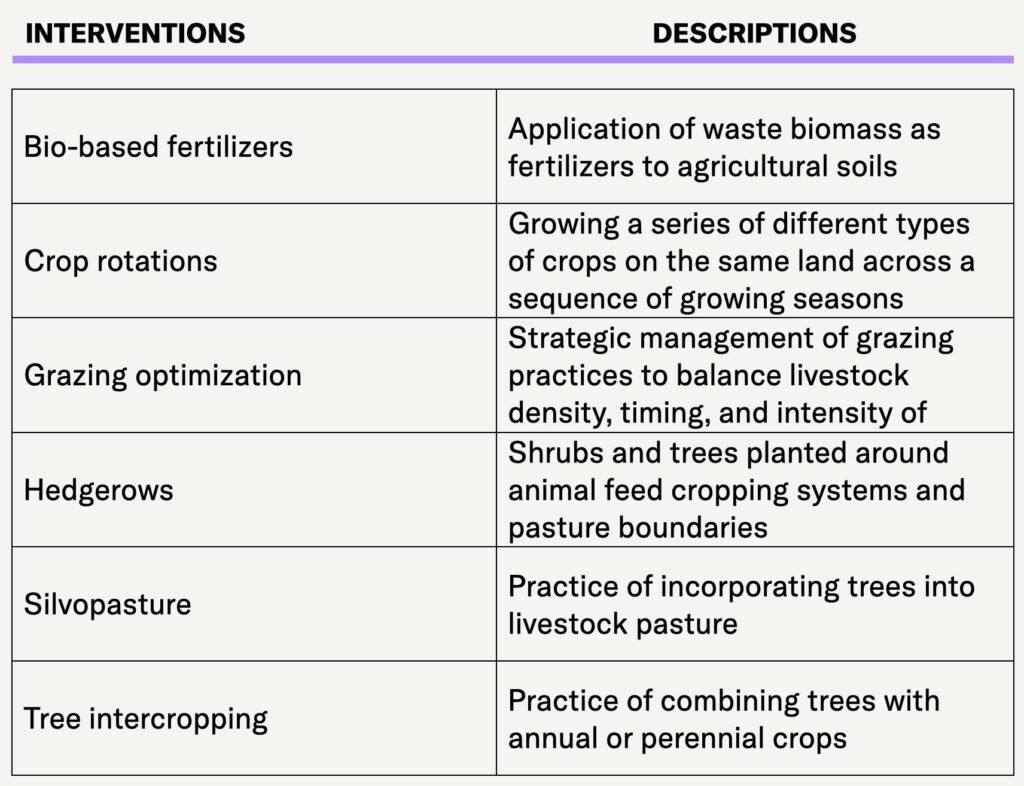
Sajeev Mohankumar is senior technical specialist, climate and biodiversity, at the FAIRR initiative, an investor network with $75 trillion AUM.
The views expressed in this guest article do not necessarily reflect those of AgFunderNews.
It’s no secret that intensive animal agriculture is pushing multiple planetary boundaries, threatening both environmental stability and the industry’s own long-term viability. Without urgent intervention, the ecological consequences could be irreversible: depleting soil, polluting waterways and accelerating climate change.
While tech-based interventions such as precision nutrient application and synthetic feed additives have a role to play, nature-based solutions offer the greatest potential for lasting and systemic change.
New analysis from FAIRR finds that six nature-based solutions have significant benefits across climate and nature, are market ready (see Table 1), offer net-positive returns within five years, and present fewer negative trade-offs than most technology driven approaches.
The shortcomings of tech-based climate solutions
Many tech-based solutions focus exclusively on greenhouse gas (GHG) emissions and but do not address broader environmental factors such as soil health, biodiversity or water cycles. This single-issue approach risks creating a lock-in effect, reinforcing industrial farming practices while delaying the systemic transformation needed for sustainable agriculture.
Furthermore, some tech-based interventions come with unintended consequences. For example, certain synthetic feed additives, designed to reduce methane emissions, have been shown to contribute to the development of antimicrobial resistance and can negatively impact the health and welfare of both humans and animals. These externalities could add up, and, at a certain point, potentially undermine their climate and nature mitigation benefits.
Technology alone cannot make agriculture sustainable. A broader regenerative approach is needed, one that prioritizes nature-based solutions alongside smart technology integration.
Growing gains with nature-based farming
FAIRR’s assessment found that nature-based interventions positively impact an average of around five planetary boundaries, compared to just three for tech-based interventions. They also have the potential to deliver 37% of the mitigation needed to meet 2030 climate targets, along with significant nature co-benefits.
In addition, nature-based interventions present fewer negative trade-offs, with only 3 out of 12 interventions flagged for potential risks, compared to 7 out of 10 tech-based approaches.
One example is tree intercropping, which integrates trees with traditional agriculture. Combining trees with animal feed crops can increase the amount of carbon in the soil and promote nutrient cycling. While this intervention has significant climate impacts through carbon removals due to sequestration, implementing this intervention also has a beneficial relationship with nature as trees improve soil health, promote biodiversity, regulate water cycles and reduce pest infestation on nearby crops.
Resilient, profitable, and underfunded
From a market-readiness perspective, almost all nature-based interventions are deployable except a few, such as enhanced rock weathering, microbial inoculants and natural feed additives, which are still undergoing testing and demonstrations.
In contrast, only a few (4 out of 10) tech-based interventions provided immediate on-farm net returns, and others required the support of carbon and nature markets to generate returns.
Nature-based solutions aren’t anti-tech; rather, technology can be used to enhance and scale regenerative practices. Benefits from nature-based interventions can be boosted through satellite and remote sensing technology, for example. Setting up monitoring, reporting and verification (MRV) systems in a cost-effective way can ensure that as much capital as possible is spent on the actual conservation and restoration programs on the ground.
Currently, nature-based interventions receive $30 million less public investment globally than tech-based interventions, together representing just 0.1% of total climate-related public finance.
Nature-based interventions need greater investment, policy support, and incentives to scale. By recognizing the lower risk and higher resilience of nature-based approaches compared to capital-intensive tech interventions, investors, governments, philanthropies and agri-food companies across the livestock value chain can help overcome barriers to scaling these solutions, reducing environmental risks and ensuring long-term value creation.
Tech has a role, but nature must lead
Nature-based solutions are market-ready, profitable, and essential for long-term agricultural resilience.
Tech will play a role in agriculture’s transformation, but without prioritizing nature-based interventions, we risk short-term fixes that fail to address systemic challenges present in our food systems.
There is no silver bullet; we need all the solutions available. But by prioritizing nature-based interventions and using tech to complement them, we can achieve positive impacts across multiple planetary boundaries, whilst also protecting investor portfolios.

The post Guest article: Why agriculture needs a nature-based revolution beyond technology appeared first on AgFunderNews.
